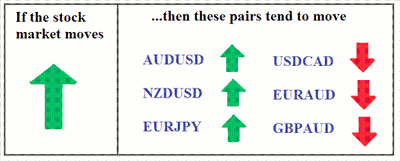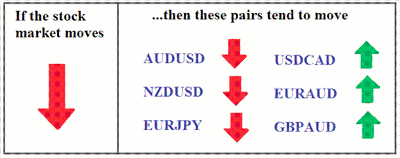Currency traders should monitor trends in the stock market as well, because major currency pairs involving the US dollar, euro, yen, and others tend to move higher or lower alongside the equity market.
Stock market movements are watched by everyone from casual investors to active traders. Many times, the movements of the stock markets can give clues about potential movements in currency trading. Below is a table of general tendencies that a trader familiar with stock trading can use to guide their forex trades.
If the stock market is said to be in a “risk-on” mode with prices on the rise, then you tend to see these currencies below trade in noted general directions.
For example, if the stock market moves higher, you tend to see the AUD/USD pair move higher as investors seek risky assets. Risky assets include the stock market and higher-yielding currencies, which currently are the Australian dollar (AUD) and New Zealand dollar (NZD).
At the same time, as investors seek out risky assets, currency pairs like the EUR/AUD and GBP/AUD tend to fall as traders look to earn the large daily dividend those pairs offer. This is known as a “carry trade” strategy.
See related: “Risk-on” vs. “Risk-off” Trades
On the other hand, if traders are in a “risk-off” mode and are averse to risk, the opposite of these relationships tend to occur.
For example, if the stock market is in a downtrend, then a currency pair such as the USD/CAD tends to move higher as traders buy the US dollar for its safe-haven status.
Regardless of the movement of the stock market, there generally exists a currency which you can buy. Now, the key is identifying a high-probability area to time an entry in the trade. Use levels of support and resistance to identify these key areas with the help of oscillators to indicate momentum.
Keep in mind that correlations move into and out of favor with one another. Therefore, a price of one instrument is not always going to move tick for tick with the other related instrument.
By Jeremy Wagner, lead trading instructor, DailyFX.com












